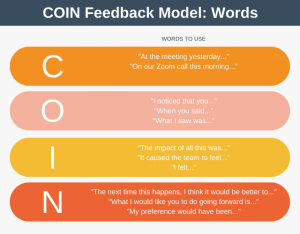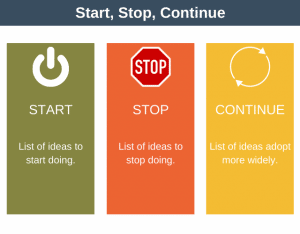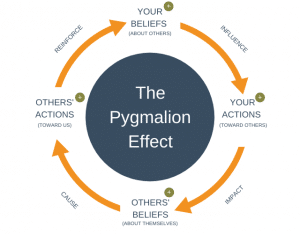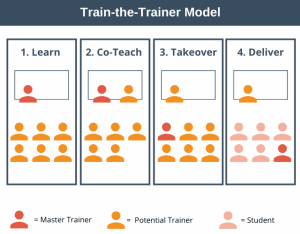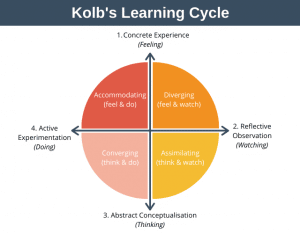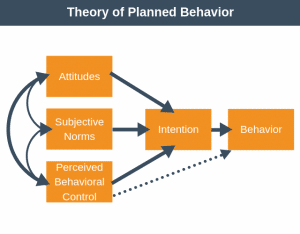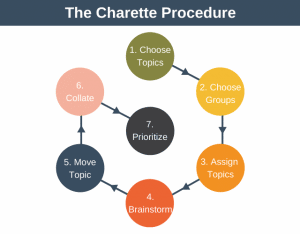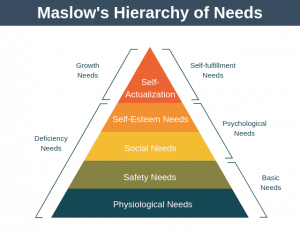Bloom’s Taxonomy is a framework for learning that can help improve the quality of how students learn and teachers teach.
Bloom’s Taxonomy can help you understand the different levels at which you master knowledge. As a learner, you can use this information to better structure your studying and gauge your competence. As a teacher, you can use this information to better plan your lessons and measure your students’ competence.
Background
Bloom’s Taxonomy was created in the 1950s by Benjamin Samuel Bloom, an American educational psychologist. The objective of the taxonomy was to assess college student performance better.
There are actually three versions of the taxonomy, one for each of the following domains:
- Cognitive domain: which focuses on the acquisition of knowledge.
- Affective domain: which focuses on the feelings, emotions, and attitudes of the individual.
- Psychomotor domain: which focuses on manual or physical skills.
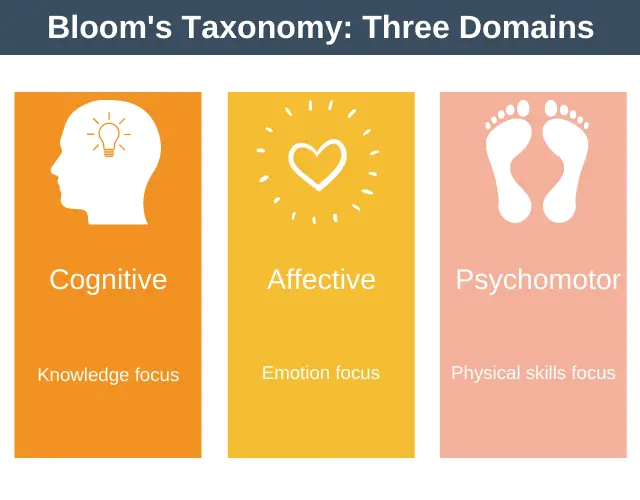
Educators often refer to these three domains as KSA (Knowledge, Skills, and Attitudes). In this article, we will concentrate on the most popular domain, the cognitive domain, concerning how people acquire knowledge.
Bloom’s Taxonomy
The first thing to notice about Bloom’s Taxonomy is that it has two versions.
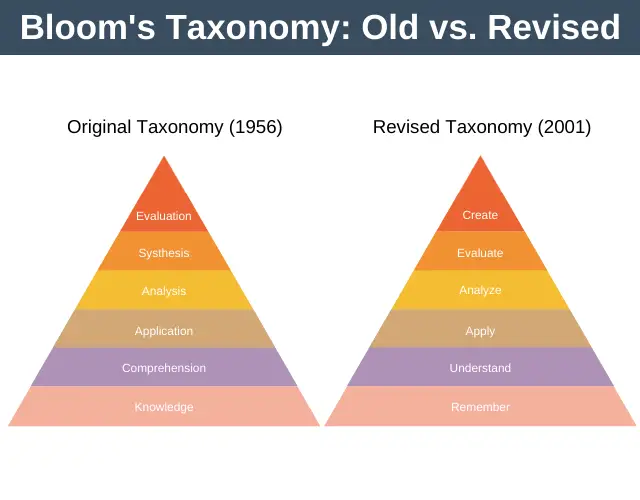
The version on the left is the original 1950s version created by Bloom. The version on the right is Bloom’s Revised Taxonomy, created in 2001 by Lorin Anderson and others. Anderson was a former student of Bloom’s.
We will focus on the Revised Taxonomy, but everything we cover in this article could equally be applied to the original version.
Bloom’s Taxonomy consists of six levels. The lowest level of challenge for learners and teachers is at the bottom of the taxonomy, and the most challenging level is at the top.

Lower Order Thinking (LOT) exists towards the bottom of the pyramid and involves memorizing basic facts. Higher Order Thinking (HOT) exists toward the top of the pyramid and requires applying knowledge, such as the ability to hypothesize and theorize. The further through the taxonomy your learning progresses, the more expert you will be in a particular subject.
It’s important to realize that lower levels are not necessarily harder than higher levels and you don’t always want to get to the higher levels. For example, if you want to take part in a TV quiz show you just need facts, not the ability to create new ideas.
Let’s look at each of the levels that comprise Bloom’s Taxonomy.
1. Remember
The first order of thinking is to remember. This is to do with recalling relevant facts and figures from long-term memory.
Action verbs associated with this level include: define, list, arrange, and repeat.
2. Understand
The second order of thinking is to understand. This is to do with comprehension and not just recall. You should be able to draw conclusions from information and summarize information.
Action verbs associated with this level include: explain, distinguish, paraphrase, and summarize.
3. Apply
The third order of thinking is to apply. Here, you implement the facts and rules you have learned to solve problems in new situations.
Action verbs associated with this level include: calculate, solve, implement, and demonstrate.
4. Analyze
The fourth-order of thinking is to analyze. This is concerned with breaking information into its constituent parts and interpreting how those parts relate to each other and to an overall structure.
Action verbs associated with this level include: simplify, analyze, compare, and research.
5. Evaluate
The fifth order of thinking is to evaluate. This is concerned with judging or critiquing information based on criteria and standards.
Action verbs associated with this level include: prove, convince, estimate, and criticize.
6. Create
The final order of thinking is to create. This concerns combining previously assimilated elements in new ways to create something new.
Action verbs associated with this level include: propose, develop, create, and invent.
How to Use Bloom’s Taxonomy
At the core of Bloom’s Taxonomy are the action verbs associated with each of the six levels.
These verbs exist to provide learners with clear objectives of what is expected of them. These objectives are called learning objectives, and they are the knowledge, skills, and capabilities a student can expect to acquire from your class or training. To use Bloom’s Taxonomy, you use the verbs to create your learning objectives.
For example, if you were giving a math workshop about prime numbers, then you might define your learning objectives as follows:
At the end of this workshop, students will be able to:
- Define a prime number (“Define” is a Remembering verb).
- Explain why 17 is a prime number (“Explain” is an Understanding verb).
- Calculate the prime factors of any prime number under 1,000 (“Calculate” is an Applying verb).
Defining learning goals in this way before you give your lesson helps both you and your students. It will help you structure your class or course better and create more appropriate exercises, and it will help your students understand precisely what they should know once they have completed your course.
Bloom’s Taxonomy Example
Imagine you are a manager at an online retailer, and you want to teach your team how to add new content to your company’s website.
Traditionally you have delivered this training simply by standing in front of a detailed PowerPoint presentation and explaining everything. However, this hasn’t proved effective, so this time you decide to use Bloom’s Taxonomy to help you structure your lessons.
When using the taxonomy, you first need to think about where you want your team to be once they have completed your training. For this example, you decide that at the end of your training, your team will be able to create new and interesting web pages that meet specific objectives and add them to your website.
You have deliberately chosen the verb ‘create’ to define your learning objective because you expect your team to be at the top of the taxonomy once the training is complete so they can create expert content on your website daily.
Next, you need to think about where your team is in the taxonomy right now. In your case, your team is utterly clueless about websites and HTML, so you decide to start teaching from the bottom of the taxonomy.
Using this start and endpoint, you use Bloom’s Taxonomy to structure your training into six lessons, each focusing on a different learning objective targetting each level of the taxonomy in turn, as follows:
- Lesson 1 (Level 1, Remember): Explain the essential HTML elements to them. At the end of the lesson, your team will be able to recall the important elements of HMTL.
- Lesson 2 (Level 2, Understand): At the end of this lesson, attendees will be able to summarize the purpose of HTML in some of your website’s actual pages.
- Lesson 3 (Level 3, Apply): At the end of this lesson, each of your team members will be able to implement their own basic web page for the first time, solving problems as they arise.
- Lesson 4 (Level 4, Analyze): Upon completing this lesson, each team member will research and explain what elements they should add to their web page to take it to the next level.
- Lesson 5 (Level 5, Evaluate): At the end of this lesson, each team member will be able to critique each other’s web pages, highlighting their advantages and disadvantages.
- Lesson 6 (Level 6, Create): At the end of the final lesson, each team member will be able to create new web pages to meet certain objectives which they will add to your website. Here, they use what they have learned to create something entirely new.

Through the six-lesson course that you’ve designed using Bloom’s Taxonomy, you hope to give your team a much deeper understanding and greater confidence around web pages than the previous approach of simply spending a day teaching them HTML with PowerPoint. You hope your team will learn much more than if you just presented to them.
Note that you don’t have to start at the bottom of the taxonomy and work your way up. You can move around the levels as you think is most appropriate for your students and what you are teaching.
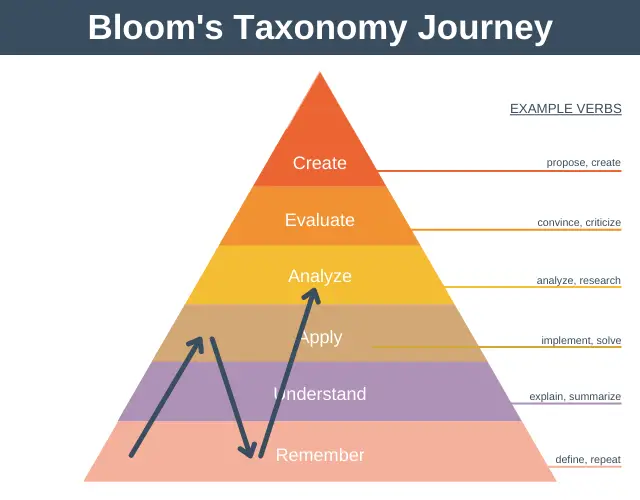
This diagram shows that you might learn some knowledge and then move on to applying it. Next, you might learn some more knowledge before moving on to analyzing and relating both pieces of knowledge.
Advantages and Disadvantages
There are several advantages and disadvantages associated with Bloom’s Taxonomy.
Advantages
- It establishes learning goals to be achieved by both teacher and student.
- By classifying learning, it allows you to think more strategically about the type of learning students should be undertaking.
- It makes it easy to assess if your lessons and evaluations are consistent with your learning objectives.
Disadvantages
- The taxonomy provides a false representation of learning. Learning is not a linear process whereby each level is separate from all others.
- The model can blind you to the integrated cognitive processes taking place in a person’s brain as they learn.
Summary
Bloom’s Taxonomy is a framework for learning that can help you understand the different levels at which you master knowledge.
As a learner, it can help you improve how you structure your studying and gauge your competence. As a teacher, it can help you to better plan your lessons and measure your students’ competence.
